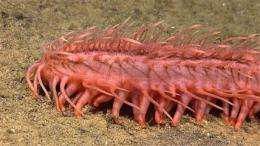Deep-sea images reveal colorful life off Indonesia

(AP) -- Scientists using cutting-edge technology to explore waters off Indonesia were wowed by colorful and diverse images of marine life on the ocean floor - including plate-sized sea spiders and flower-like sponges that appear to be carnivorous.
They predicted Thursday that as many as 40 new plant and animal species may have been discovered during the three-week expedition that ended Aug. 14.
More than 100 hours of video and 100,000 photographs, captured using a robotic vehicle with high-definition cameras, were piped to shore in real-time by satellite and high-speed Internet.
Verena Tunnicliffe, a professor at the University of Victoria in Canada, said the images provided an extraordinary glimpse into one of the globe's most complex and little-known marine ecosystems.
"Stalked sea lilies once covered the ocean, shallow and deep, but now are rare," she said in a written statement. "I've only seen a few in my career. But on this expedition, I was amazed to see them in great diversity."
Likewise, Tunnicliffe has also seen sea spiders before, but those were tiny in comparison, all around one-inch (2.5 centimeters) long: "The sea spiders ... on this mission were huge. Eight-inches (20-centimeters) or more across."
One animal captured on video looks like a flower, covered with glasslike needles, but scientists think it is probably a carnivorous sponge. The spikes, covered with sticky tissue, appear to capture food as it passes by.
Scientists used powerful sonar mapping system and the robotic vehicle to explore nearly 21,000 square miles (54,000 sq. kilometers) of sea floor off northern Indonesia, at depths ranging from 800 feet (240 meters) to over two miles (1.6 kilometers).
The mission was carried out by the U.S. National Oceanic and Atmospheric Administration's ship, the Okeanos Explorer. An Indonesian vessel, the Baruna Jaya IV, also took part, collecting specimens that, together with all rights for future use, will remain in the country.
Confirmation that a species is new involves a scientific peer review and other steps and can take years.
More information:
http://oceanexplorer.noaa.gov/
http://oceanexplorer.noaa.gov/okeanos/welcome.html
http://shiptracker.noaa.gov/
©2010 The Associated Press. All rights reserved. This material may not be published, broadcast, rewritten or redistributed.


















